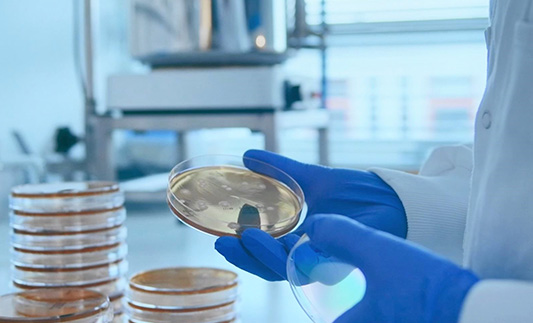

We know probiotics are living bacteria, but in reality, they’re more. Much more. Live bacteria are crucial for health and an everyday part of our daily life. The gastrointestinal tract holds thousands of different species of live bacteria, with trillions of individual bacterial strains. It’s important to note though that these bacteria are not in themselves considered probiotics.
Within our gut and mouth, on the skin, and elsewhere on the body, there are a number of different bacterial strains. Some of these are beneficial to us, while others are harmful. The range of microorganisms, including bacteria, viruses, fungi and archaea, is called the microbiota. The important point for the microbiota is to maintain balance between the ‘good’ and the ‘bad’ bacteria. A shift towards the bad creates an unhealthy balance, increasing the risk for unwanted symptoms and diseases. This is where probiotics are beneficial. Probiotics can assist in maintaining a healthy microbial balance.
We understand that our body contains live bacteria but we can also consume additional bacteria. They come in several different formats, sometimes defined bacteria as in probiotics, but many times just live bacteria. The bacteria can be ”vivid” as in juice or yoghurt. In ice cream, live bacteria are ‘resting’. If they come in a capsule or tablet, they’re freeze dried and are essentially in sleep mode.
A live bacterial culture, found for example in kombucha, kimchi and some dairy products, does not need to be defined. This means that the bacterial strains don’t have to be stated on the packaging, unless the product claim to be “probiotic”. In summary, live bacteria can be probiotics, but not necessarily.
Probiotics are defined as ‘live microorganisms that confer a health benefit on the host when administered in adequate amounts.’ However, this is not really as simple as it sounds, so we’ll break it down step by step. What does it take to be called a true probiotic?

Among microorganisms, there are bacteria, fungi, viruses, archaea, yeasts and more. The most common probiotic microorganisms are bacteria. From here, we’ll only focus on the bacterial sub-division of microorganisms. To be called a probiotic, the bacteria must be alive, not killed by heat or deactivated. As mentioned before, the bacteria should be either “vivid”, “resting” or freeze-dried. To be considered ‘alive’, the bacteria must maintain life through the entire shelf life of any probiotic product.
This puts constraints on external conditions through product production, packaging, and storage. Bacteria are sensitive to high temperatures and humidity, so storage under direct sunlight or long cargo journeys in a non-temperate environment is not optimal. Humidity is a common problem for a lot of products that contain many ingredients. This includes vitamins, fibers and other additives such as nutraceuticals or botanicals which may have a fairly high water content. Therefore, all this knowledge is crucial when producing a probiotic product, and for choosing the right “companions” to go into the final product which complements the sensitive nature of probiotics.
Probi has spent years mastering the art and science of manufacturing probiotics. We know how to safeguard the vitality of bacteria at each manufacturing stage.

In addition to living organisms, getting just the right amount of probiotics is also important. Usually the rationale behind a recommended dosage is based on clinical studies. The way to quantify bacteria is by “colony forming units”, or “CFU”, which should be indicated on the product’s package. CFU means the number of colonies of living bacteria that can be found under specific conditions. If the product contains several different bacterial strains, each strain should be defined and contain the clinically relevant dosage.
For example, if the strain LP299V® is added in a multistrain product, the CFU for LP299V® needs to be 10 billion, which is the clinically defined amount for this strain. “Adequate amounts” is inclusive of the recommended CFU at the end of shelf-life. Because there is natural decline of living bacteria during storage, it must be considered at the production stage.
At Probi, we make complex formulations seem simple – our dedicated team of experts will help to achieve the required CFU and shelf-life goals.

To be a true probiotic, there must be a clear health benefit for the host. Probiotics for human consumption means that the strain (or strains) has been revealed in one or more clinical studies to have a clear health benefit when consumed, in comparison with a placebo or non consumption. “For the host” indicates the health benefit should be for whom the probiotics are intended. A study showing health benefits in mice is therefore not a sufficient study to show the benefit for human consumption.
Another health benefit aspect is the selection of bacterial strains. There are many different probiotic strains that differ from one another even if they belong to the same species. The health benefits often prescribed to probiotic strains can be divided into effects that are widespread between different species and strains or strain specific effects. The most clinically documented probiotic strains all have strain-specific effects. These health benefits can touch on many different areas of health, including gastrointestinal, immune, women’s, metabolic, oral, and bone health.
Probi has clinically documented benefits for all these health areas. The probiotic strain LP299V® is the world’s most clinically documented L. plantarum strain, with strain-specific effects on increasing iron uptake and supporting the gastrointestinal barrier by promoting the production of mucus, just to mention some.

Are all fermented foods probiotics? Find out more and make sure you know where to find your probiotics.

Why CFU are important? Is a higher CFU value more effective? Let us explain how this matters for your product.

Bacteria are classified into different groups according to traits. Find out how you can differentiate between the bacteria.